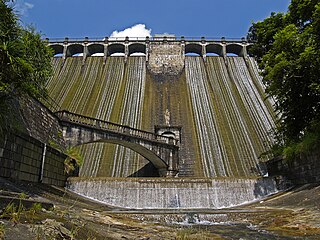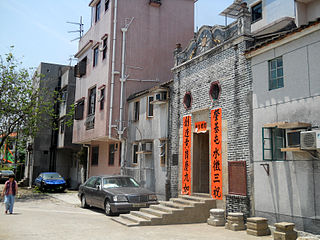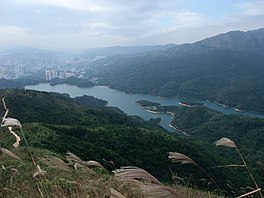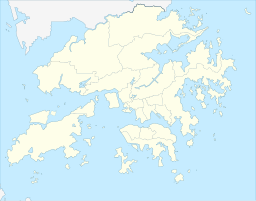
Most of the walled villages of Hong Kong are located in the New Territories.

The Kowloon Group of Reservoirs is located in the Kam Shan Country Park,north of Kowloon,Hong Kong. They include:

Kowloon Reception Reservoir,part of the Kowloon Group of Reservoirs,is a reservoir in Kam Shan Country Park,Sha Tin,New Territories,Hong Kong.

Lam Tei is an area in the Tuen Mun District of the New Territories,Hong Kong. The region lies at the north end of Tuen Mun city. It is highly rural,with Miu Fat Buddhist Monastery being a landmark of the region.

Hau Wong or Hou Wang is a title that can be translated as "Prince Marquis" or "Holy Marquis". It is not any one person's name. Hau Wong refers usually to Yeung Leung-jit,a loyal and courageous general. Despite his failing health,he remained in the army to protect the last emperor of Southern Song Dynasty when he took refuge southwards in Kowloon.

Tin Hau temples in Hong Kong are dedicated to Tin Hau (Mazu). Over 100 temples are dedicated to Tin Hau in Hong Kong. A list of these temples can be found below.

The Aberdeen Reservoirs are a group of two reservoirs,consisting of the Upper Aberdeen Reservoir (香港仔上水塘) and the Lower Aberdeen Reservoir (香港仔下水塘),in Aberdeen,Hong Kong.

Tung Tau Tsuen is a village in the Yuen Long Kau Hui area of Yuen Long District,Hong Kong.

Ying Lung Wai is a walled village in the Yuen Long Kau Hui area of Yuen Long District,Hong Kong.

Yuen Long Kau Hui is an area in Yuen Long,Yuen Long District,in the western New Territories of Hong Kong.

Nam Pin Wai,sometimes transliterated as Nam Bin Wai,is a walled village in the Yuen Long Kau Hui area of Yuen Long District,Hong Kong.

Wing Lung Wai is a walled village located in the Kam Tin area of Yuen Long District,in Hong Kong. Three other walled villages,Kat Hing Wai,Tai Hong Wai,and Kam Hing Wai are located nearby and were built around the same time.

Tuen Tsz Wai is a village of Hong Kong,located in the Lam Tei area,in the northern part of Tuen Mun District. Part of the village is a historic Punti walled village.

Nai Wai aka. Wong Kong Wai (黃崗圍) is a walled village in Lam Tei,Tuen Mun District,Hong Kong.

Ho Sheung Heung is an area in Sheung Shui,North District,Hong Kong.

Kam Tsin Wai is a village located in the south of Shek Kong Airfield,in Pat Heung,Yuen Long District,Hong Kong.

Kam Tin Shing Mun San Tsuen or Kam Tin San Tsuen (錦田新村) is a village in the Kam Tin area of Yuen Long District,Hong Kong.

Shing Mun Valley is a valley in the Shing Mun area of Hong Kong.






















